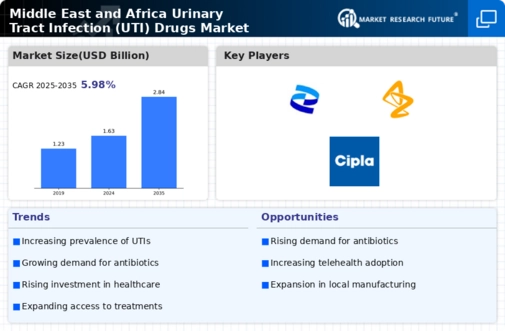Mea Uti Drugs Size
MEA UTI Drugs Market Growth Projections and Opportunities
The market for urinary tract infection drugs in the Middle East and Africa (MEA) is influenced by a number of market forces that collectively shape its dynamics. One of the major contributors to market growth has been the increasing incidence of UTIs in the region. The MEA region, with its diverse population and various health care systems, is grappling with a rising occurrence of UTIs leading to high demand for effective pharmaceutical interventions.
More so, demographic structure within MEA region significantly affects the UTI drugs markets. Despite having an aging demography profile, it still has a rapidly growing population mainly concentrated in urban areas. Due to weakened immunity among old people, they are very vulnerable to UTI hence they make up significant consumers of UTI drugs. Also changes in life style such as increased stress and sedentary behavior also adds on general increase in prevalence rates for infections resulting from UTIs hence there is greater need for medications used to treat them.
The regulatory landscape and healthcare policies within MEA have significant propositions on the urinary tract infection (UTI) drug market. In this regard, strict regulations, changing reimbursement mechanisms as well as state initiatives aimed at improving healthcare infrastructure determine access and affordability of UTI drugs. Market players must learn how to effectively navigate through these regulations while ensuring compliance and penetrating the markets.
Technological advancements and innovations in drug development are critical drivers of market dynamics. A rising number of scientific research projects focused towards urinary tract infection drugs have taken place across MEA leading to introduction of new formulas or treatment methods.Creative advances thus give additional treatment alternatives for different medical practitioners besides fuelling competition among pharma companies angling for bigger shares.
Economic factors such as overall economic health conditions influencing MEA countries also contribute towards Urinary Tract Infection drugs marketing.Economic stability coupled by growth positively influences spending on healthcare making medicines affordable by individuals’ pockets.Conversely business slowdown or uncertainties might pull down temporary market growth as customers become more price sensitive thus UTI drugs will lose their purchasing power.
Partnerships and collaborations within the pharmaceutical industry are some of the key market factors shaping the MEA UTI drugs market. Strategic alliances between pharmaceutical companies, research institutions, and healthcare organizations facilitate the sharing of resources, expertise, and technology. These partnerships can speed up drug development processes in addition to enhancing market presence hence boosting overall MEA urinary tract infection drugs markets.
Lastly cultural and social factors also influence seeking medical care and preferences for treatment which impact on demand for urinary tract infection drugs. Consequently awareness campaigns, educational programs as well as cultural beliefs shape people’s understanding on UTIs and its cure affecting decision making process of both patients’ and health care providers’.







Leave a Comment